-

人教版新目标初中英语八年级下册It’s a nice day, isn’t it教案2篇
"Hello! Welcome to English class! Introduce yourself. Meet your new classmates." That's what the teacher says. What do you say? "Oh no!" It can be difficult talking to new people. But it can be fun, and you can make friends. How do you do it? Make small talk. Small talk is polite conversation. "Wang Nan is a great pingpang player, isn't she?" "I'd love to meet her, wouldn't you?" "It's been raining a lot, hasn't it?" Tag questions are a form of polite speech. To make small talk successfully, you should know how to make them. You should also know what topics to talk about. Try to learn this unit carefully. The next time you're in English class, you'll find out. Making small talk's easy, isn't it? (“你好!欢迎你!请做一下自我介绍。认识一下你的新同学。”通常在课上老师会这样说。你会说什么呢?“噢,不!”与陌生人谈话太困难了。但是这也很有意思,并且你还能交到朋友。你该怎么做呢?闲聊。闲聊指得是礼貌的对话。“王楠是一个很棒的乒乓球运动员,不是吗?”“我希望自己能认识她,你呢?“今年的雨水很多,不是吗?”反意疑问句是一种礼貌用语。为了使得谈话成功,你应该知道怎样去进行闲聊。你还应该知道与不同的人该谈论什么样的话题。认真的学习这个单元吧,下次在英语课上,你会发现与大家展开谈话是一件很容易的事情,不信我们来试试。)

人教版新目标初中英语八年级下册He said I was hard-working教案2篇
This activity introduces some new vocabulary and provide oral practice using the target language.Task 1 . Ask four students to stand in front of the class, and the teacher asks them the following questions as a reporter.1.What are you going to do when you grow up?2.What are you going to do next week?3.What are going to do after school?The students will give different answers, then ask a good student to report what they said.I am going to e a doctor.What did she say?----------She said she was going to be a doctor.I am going to have a party on Friday night.What did he say?-------He said he was going to have a party on Friday night.I am going to do my homework.What did she say ?------ She said she was going to do her homework.I am going home after school.What did she say?-----She said she was going home after school.Say In this unit we are going to learn to use words like to report what someone said.Task 2. Read the instructions. Then ask a student to read the four questions. And write the words on the Bb. Explain what soap opera is.Task 3. Ask the students to Look at the pictures, point out the TV screens in the picture. Ask one girl to read what Marcia said.What did Marcia say? She said She said she was having a surprise party for Lana on Friday night. Repeat the other pictures in the same way.Activity3. Listen and number the pictures in activity 1a.

人教版新目标初中英语八年级下册How long have you been collecting shells教案2篇
Step Ⅱ Show the new words on the screen and teach the new words. Read the new words to students and ask them to repeat.Step Ⅲ 3aThis activity introduces new vocabulary and provides reading practice using the target language.In this activity first look at the four pictures.T: What can you see in the pictures?Ss: Four snow globes.T: Right. There are four snow globes in the pictures. And what are they?Ss: They are a monster, two polar bears, two penguins and a birthday cake.Write these words on the blackboard: snow globe; monster; polar bear; penguin and birthday cake. Read them to the class and ask students to repeat each one. Make sure students understand each word.Use a computer to show the E-mail message on the screen and read the message to students.Get students to read the e-mail on their own, and then draw lines connecting each snow globe and its description.Correct the answers.AnswersA line should connect each snow globe picture with the words that describe it in the letter.Step Ⅳ 3bThis activity provides writing practice using the target language.First review Activity 2a on Page 47.Then ask students to complete the message according to Activity 2a.Some partial sentences are given to students. Write about one person's collection.When students work, walk around the room checking the progress and offering help as needed.When they finish, ask some students to read their messages to the class.

人教版新目标初中英语八年级下册What were you doing when the UFO arrived教案2篇
(一).知识方面: 1.培养学生能运用过去进行时来描述、谈论过去某个时间正在发生的事情或动作的意识和能力,能就过去某个时间正在发生的动作做出正确的描述。 2.培养学生的想象力和角色扮演的合作能力。 3.培养学生讲述过去发生的事情经过的能力。能正确运用一般过去时来讲述故事。 (二).技能方面: 1.本单元的语言目标是Talk about past events and tell a story(谈论过去的时间和讲述一个故事),围绕这一目标,要涉及句型: What were you doing when the UFO arrived? ----I was sitting in the barber’s chair. The barber was cutting my hair. 因此必须学习standing、studying、cleaning、sleeping、cooking、making、eating、cutting、等表示地点的词,以便为上述句型提供语言材料。2.学习过去进行时的有关知识。Was/were+现在分词,是该时态的表达式。 3.在学习过程中,要区分The boy was walking down the street when the UFO landed.和While the boy was walking down the street, the UFO landed.这两种由when和while引导的状语从句的句型结构。注意它们的不同。

人教版新目标初中英语九年级上册Teenagers should be allowed to choose their own clothes教案2篇
Step 1 Greeting Greet the class and check the homeworkStep 2 A duty report The S on duty gives a report on the rules in his home and lead in 3a “Sun Fei’s and Wu Yu’s rules” Step 3 ReadingSs read the conversation and write the two girls’ rules in the chart. Check the answers.Get Ss to read after the tape and then read aloud by themselves. Then, T explains the language points.Step 4 Pairwork 3bRole play. Use the information in chart to practice with the conversation in 3a covered. They can look at the sample conversation in the right box.Step 5 Task 2 “Who’s the best reporter?”Make a survey by asking any 5 students the questions in the chart in activity 4. Then give out a report about it. See who is the best reporter? And the best reporter will get a nice ball-pen.Step 6 Summary and homework:Write out the report in your exercise-books.Period ThreeStep 1 Greeting and a duty reportThe S gives a duty report talking about his experience of being late for school. Lead in the question “Do you ever get to school late? How often do you get to school late? Always, usually, sometimes, or never?Step 2 1a Get Ss to finish writing.Step 3 Pairwork 1b Get Ss to talk about their answers with their partners using the sample conversation in the box on the right.Step 4 Listening practice2a Lead-in: What will happen if you get to school late? What about Peter? Let’s listen to a conversation between Peter and his father. Get Ss to finish 2a (As usual, for the first time, Ss only listen.) Check the answers.

人教版新目标初中英语九年级上册How do you study for a test教案2篇
内容提示本单元主要内容是学会利用verb十by/with gerund表示方式方法来讨论学习英语的策略,认识自己在学习方面的长处和不足。初步了解现在完成时的结构和用法。现在完成时由助动词have/has+动词的过去分词构成,主要表示过去发生的某一动作对现在仍有影响或造成的后果,常与already,yet,just,ever,never等副词连用。教学目标一、学习目标(Language Goal) 1. Talk about how to study . 学会讨论各种学习方法和策略。2. Find out your suitable learning methods. 找出适合自己的学习方法。 二、语言结构(Language Structures) 1. Verb + by with gerund by+动名词短语 表示“通过…途径,方法” 2. How questions have引导的特殊疑问句 三、目标语言(Target Language) 1. How do you study for tests ? 你是怎样准备考试的?Well , I study by working with my classmates. 哦,我和同学们一起学习。2. Have you ever studied with a group ? 你曾经参加过学习小组吗?Yes , I have . I’ve learned a lot that way . 是的,参加过。通过这种方式我学了许多。

人教版新目标初中英语九年级上册Where would you like to visit教案2篇
The First PeriodⅠ.Teaching Aims and DemandsKnowledge Objects(1) Key Vocabularytiring, educational, fascinating, thrilling, peaceful, exotic, trek, jungle, take it easy, explore, historic, site(2) Target LanguageWhere would you like to go on vacation?I’d like to trek through the jungle, because I like exciting vacations.2. Ability Objects(1)Train students to talk about places they would like to visit with the target language.(2)Train students to describe vacations with different adjectives.(3)Train students' listening skill.3. Moral Object,It′s more interesting to go on vacating somewhere instead of staying at home.Ⅱ. Teaching Key Points1. Key Vocabularytiring, educational, fascinating, thrilling, peaceful, exotic, trek, jungle, take it easy, explore, historic, site2. Target LanguageTalk about different places with the target language.Ⅲ. Teaching Difficult Points1. Describe vacations with different adjectives.2. Talk about different places with the target language.Ⅳ. Teaching Methods1. Teaching by illumination2. Teaching by doing chain drills3. Teaching by pairworkⅤ. Teaching Aids1. A tape recorder2. Some pictures of different places with famous views

人教版新目标初中英语九年级下册We’re trying to save the manatees教案2篇
本单元主要围绕着有关濒临灭绝的动物这一话题,学习了应该怎样保护我们的环境,以及就某一问题展开辩论。目标提示语言目标能够运用所学知识,就某一问题展开辩论。认知目标1、复习一些语法:现在进行时、一般现在时、用used to 表示一般过去时、现在完成时、一般过去时的被动语态。2、学会表达同意和不同意。3、学会以下基本句型:We’re trying to save the manatees.Manatees eat about 100 pounds of food a day.There used to be a lot of manatees.In 1972,it was discovered that they were endangered.Some of the swamps have become polluted.情感目标了解一些濒临灭绝的动物的生活习性和濒临灭绝的原因,教育学生应该如何保护环境。教学提示充分利用多媒体等教学设备,创设与本课话题相关的情境,如各种不同种类的动物、动物园以及有关环境的画画等等。围绕着本单元的教学目标,设计一些贴近学生实际的教学任务,如让学生谈论自己最喜欢的动物,如何拯救濒危动物,如何保护环境等等。让学生根据所学知识,就动物园是否对动物有利以及其他的话题进行辩论。

人教版新目标初中英语八年级上册How was your school trip教案2篇
“Go for it!” is based on “Task-Based Language Teaching”. It adheres to “The authenticity principle”, “The form-function principle”, “The task dependency principle” and “The principle of learning by doing”. These principles all accord with the demands of curriculum focus.In and of Grade Seven (II), “Go for it!”, students have learned “The Simple Past Tense”. And it appears again in of Grade Eight (I). teaches students more about how to talk about events in the past. In addition, it gives affirmative and negative statements in the past tense, such as the sentence patterns “Did you see …?” “Were there …?” “Did you go …?” As the first part of Unit 8, Section A opens with a picture presenting the last school trip in the aquarium and continues with several step-by-step practice activities, which are all good for students to master “The Simple Past Tense”. Doing well in Section A will help students integrate the new target language with that in Section B. Thus, they can describe the events in the past freely and foster their own ability of reflecting and practicing. II. Teaching ObjectivesTeaching objective is the beginning and aim of teaching activities. According to the overall goal of the English elementary course--- improve students' synthetic ability of language application, which should be based on the development of students’ “Language knowledge”, “Language skills”, “Character building”, “Learning strategies” and “Cross-cultural awareness”. The teaching objectives are described as follows(I). Knowledge objectivesi. Master the simple past tense of regular and irregular verbsii. Recite the new words and expressions about the last school trip in the aquarium, including their pronunciation and intonation

人教版新目标初中英语八年级上册How do you get to school教案2篇
Step Ⅶ Role play ( Work on 1b)1. First ask two students to read the dialogue to the class.Sa: How do you get to school?Sb: Well, I ride my bike to the subway station. Then I take the subway.2. Now work with a partner.Suppose you use two kinds of transportation to get to school \Hangzhou\Beijing... (bus, train, subway, walking, bike, etc.) Tell how you get there. You may use the phrases in 1a.3. Then ask different pairs of students to present their conversations to the class.Step ⅧListening1. Work on 2a(1) First ask students to read the list of information that Thomas wants to know.…where Nina lives.…how far from school she lives.…how long it takes to get to school.…how she gets to school.…what she thinks of the transportation.(2) Tell students what transportation and bus stop mean.bus stop 汽车站 transportation n. 运送;运输Then tell students we'll hear a recording. Please put a checkmark in front of each thing that Thomas wants to know.(3) Now play the recording for students.( Have students pay attention to the sample answer.) (4) Then correct the answers.

人教版新目标初中英语八年级上册What are you doing for vacation教案2篇
Teaching goals : 1. Words & phrases: babysit ,get back , fishing , rent , think about , decide(on) , tourist etc. 2. How to talk about future plans . 3. 现在进行时表示将来计划或行动. 4. 特殊疑问句(where , when , how long引导) Important and difficult points : Drills :What are you doing for vacation ? I’m watching TV . When are you going ? I’m going … . How long are you staying ? We’re staying for five days . Teaching aids : cards and a tape ,a large wall calendar . Period 1 Teaching procedures : Step 1Leading in1. Free talk . 2. Put up the wall calendar . T: I’m staying home on Saturday (pointing to next Saturday ).Ss repeat . Ss: I’m staying home on Saturday . T: OK. Today we’ll learn how to talk about future plans. Step 2Pre-task SB Page 13 , 1a . 1. Look at the picture carefully and tell what you see in the picture . 2. Write the activities from the pictures in the box and add some more . 3. Practice reading . Step 3While-task1. Using the activities we write in 1a to make conversations .For example :What are you doing for vacation ? I’m visiting my uncle . 2. Pairwork .Practice in pairs . 3. 用第三人称练习对话.
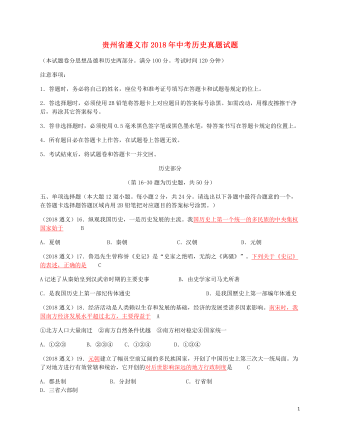
贵州省遵义市2018年中考历史真题试题(含答案)
村料一 宋代是中国历史上最具魅力的时代。……到了宋代便超越西亚而居于世界前列。……由于宋代文明的刺激,欧洲文明向前发展了。宋代文明深深地响了世界。——日本史学家官崎市定材料二 18世纪中期,术材匱乏引发能源危机,使英国人毅然在热能和机械能领域实现转轨,通过调整能源结构实现了国家整体性产生变迁,完成了经济史的重大转型,由此引发了第一次工业革命。在始于19世纪末的第二次工业命中,电能的广泛应用带领人类社会步入了电气时代……一一朱启贵《第三次工业革命浪潮下的转型选择》(1)材料一“宋代文明”中的某项成果为环球航行和新大陆的发现提供了重要的技术支持,这项成果具体是指什么?(2分)
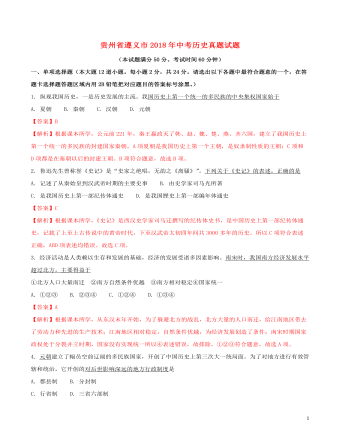
贵州省遵义市2018年中考历史真题试题(含解析)
村料一 宋代是中国历史上最具魅力的时代。……到了宋代便超越西亚而居于世界前列。……由于宋代文明的刺激,欧洲文明向前发展了。宋代文明深深地响了世界。——日本史学家官崎市定材料二 18世纪中期,术材匱乏引发能源危机,使英国人毅然在热能和机械能领域实现转轨,通过调整能源结构实现了国家整体性产生变迁,完成了经济史的重大转型,由此引发了第一次工业革命。在始于19世纪末的第二次工业命中,电能的广泛应用带领人类社会步入了电气时代……一一朱启贵《第三次工业革命浪潮下的转型选择》(1)材料一“宋代文明”中的某项成果为环球航行和新大陆的发现提供了重要的技术支持,这项成果具体是指什么?
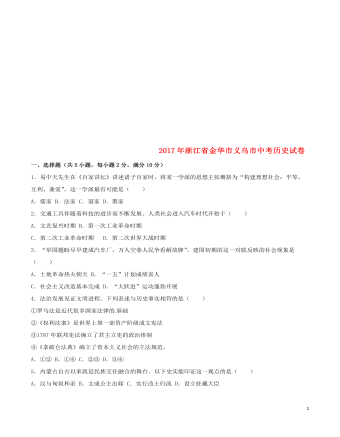
浙江省义乌市2017年中考历史真题试题(含解析)
2016年,我国农业部发布《关于推进马铃薯产业开发的指导意见》,推进马铃薯主粮化战略。阅读材料,回答问题。(1)根据如图,写出马铃薯传入欧洲所经过的大洋,并指出马铃薯走向世界最初源于哪一历史事件。(2)他山之石,可以攻玉。根据相关链接,说说美国的做法对我国推进马铃薯产业开发有哪些启发。【相关链接】1939年美国出台《市场推广法案》,依据法案成立了国家马铃薯委员会,进行贸易立法和纠纷的解决;各州根据不同的气候和土壤条件,选择种植不同用途的马铃薯;专门成立研究中心,进行新品种培育、深加工处理、化肥农药使用量、节水等研究。
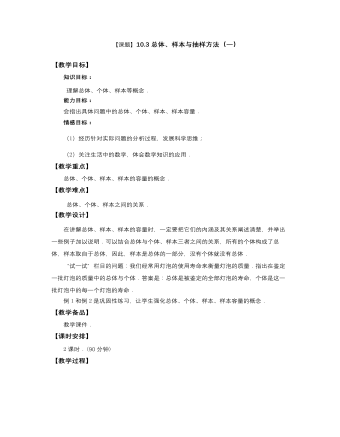
高教版中职数学基础模块下册:10.3《总体、样本与抽样方法》教学设计
教 学 过 程教师 行为学生 行为教学 意图时间 *揭示课题 10.3总体、样本与抽样方法(一) *创设情境 兴趣导入 【实验】 商店进了一批苹果,小王从中任意选取了10个苹果,编上号并称出质量.得到下面的数据(如表10-6所示): 苹果编号12345678910质量(kg)0.210.170.190.160.200.220.210.180.190.17 利用这些数据,就可以估计出这批苹果的平均质量及苹果的大小是否均匀. 介绍 质疑 讲解 说明 了解 思考 启发 学生思考 0 10*动脑思考 探索新知 【新知识】 在统计中,所研究对象的全体叫做总体,组成总体的每个对象叫做个体. 上面的实验中,这批苹果的质量是研究对象的总体,每个苹果的质量是研究的个体. 讲解 说明 引领 分析 理解 记忆 带领 学生 分析 20*巩固知识 典型例题 【知识巩固】 例1 研究某班学生上学期数学期末考试成绩,指出其中的总体与个体. 解 该班所有学生的数学期末考试成绩是总体,每一个学生的数学期末考试成绩是个体. 【试一试】 我们经常用灯泡的使用寿命来衡量灯炮的质量.指出在鉴定一批灯泡的质量中的总体与个体. 说明 强调 引领 观察 思考 主动 求解 通过例题进一步领会 35

高教版中职数学基础模块下册:10.4《用样本估计总体》教学设计
教 学 过 程教师 行为学生 行为教学 意图时间 *揭示课题 10.4 用样本估计总体 *创设情境 兴趣导入 【知识回顾】 初中我们曾经学习过频数分布图和频数分布表,利用它们可以清楚地看到数据分布在各个组内的个数. 【知识巩固】 例1 某工厂从去年全年生产某种零件的日产记录(件)中随机抽取30份,得到以下数据: 346 345 347 357 349 352 341 345 358 350 354 344 346 342 345 358 348 345 346 357 350 345 352 349 346 356 351 355 352 348 列出频率分布表. 解 分析样本的数据.其最大值是358,最小值是341,它们的差是358-341=17.取组距为3,确定分点,将数据分为6组. 列出频数分布表 【小提示】 设定分点数值时需要考虑分点值不要与样本数据重合. 分 组频 数 累 计频 数340.5~343.5┬2343.5~346.5正 正10346.5~349.5正5349.5~352.5正  ̄6352.5~355.5┬2355.5~358.5正5合 计3030 介绍 质疑 引领 分析 讲解 说明 了解 观察 思考 解答 启发 学生思考 0 10*动脑思考 探索新知 【新知识】 各组内数据的个数,叫做该组的频数.每组的频数与全体数据的个数之比叫做该组的频率. 计算上面频数分布表中各组的频率,得到频率分布表如表10-8所示. 表10-8 分 组频 数频 率340.5~343.520.067343.5~346.5100.333346.5~349.550.167349.5~352.560.2352.5~355.520.067355.5~358.550.166合 计301.000 根据频率分布表,可以画出频率分布直方图(如图10-4). 图10-4 频率分布直方图的横轴表示数据分组情况,以组距为单位;纵轴表示频率与组距之比.因此,某一组距的频率数值上等于对应矩形的面积. 【想一想】 各小矩形的面积之和应该等于1.为什么呢? 【新知识】 图10-4显示,日产量为344~346件的天数最多,其频率等于该矩形的面积,即 . 根据样本的数据,可以推测,去年的生产这种零件情况:去年约有的天数日产量为344~346件. 频率分布直方图可以直观地反映样本数据的分布情况.由此可以推断和估计总体中某事件发生的概率.样本选择得恰当,这种估计是比较可信的. 如上所述,用样本的频率分布估计总体的步骤为: (1) 选择恰当的抽样方法得到样本数据; (2) 计算数据最大值和最小值、确定组距和组数,确定分点并列出频率分布表; (3) 绘制频率分布直方图; (4) 观察频率分布表与频率分布直方图,根据样本的频率分布,估计总体中某事件发生的概率. 【软件链接】 利用与教材配套的软件(也可以使用其他软件),可以方便的绘制样本数据的频率分布直方图,如图10-5所示. 图10?5 讲解 说明 引领 分析 仔细 分析 关键 语句 观察 理解 记忆 带领 学生 分析 25

人教版新课标小学数学一年级下册小小商店教案2篇
3、同学们,你们看今天老师带来了什么?(出示一个学生喜欢的玩具)这是昨天老师去商店时买的,猜猜看,这个需要多少钱?(学生猜,教师可提示,最后得出正确标价)今天我们也来开个小小商店玩一玩买卖商品的游戏,想玩吗?4、选营业员及经理。我觉得当营业员最重要的是精通业务,计算能力强。谁想来当?(等学生举手后,教师选出4人。)考虑到我们呆会儿买的人会比较多,每个柜台一个营业员忙不过来,我还准备再选4名商店经理,做好以下几项工作:1)做好接待服务工作,顾客有困难能主动帮助。2)做好买卖过程中的组织工作,让大家有秩序地买商品。3)当营业员计算碰到困难时,两人能商量着解决。觉得自己能做到以上三点的同学可举手参加竞选。(学生举手后,选出4名经理)
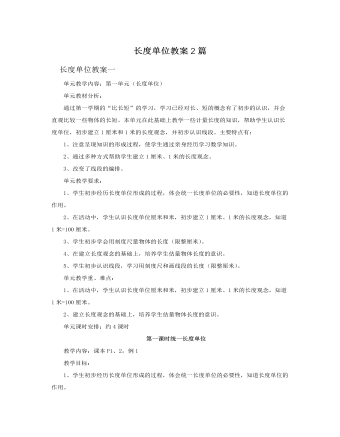
人教版新课标小学数学二年级上册长度单位教案2篇
l尺子上每相邻的两条长刻度线之间的一大格的长度都是1厘米。师:我们大家现在一起用手比划一下,1厘米多长。互相看一下,计住了吗?闭上眼睛想一想,1厘米有多长。3、认识几厘米师:我们现在知道1厘米有多长了,那3厘米又有多长呢?师:同学们还能在尺子上找到其他3厘米的长度吗?4、用厘米量师:刚才上课时,老师展示的2根线绳,到底哪一根长一点呢?现在,同学们先估计一下这两根线绳各自多长,然后在测量比较一下,好吗?师:结果是哪根线绳长一点呢?能说说你是怎么量的吗?三、知识拓展1、师:老师这里有一把尺子,可是它断了一节,没有刻度“0”,只剩下刻度3到刻度10,那么这把尺子能不能用来量物体的长度啊?同学们能不能帮老师想一想办法,好吗?2、其他测量长度的工具(课件展示)
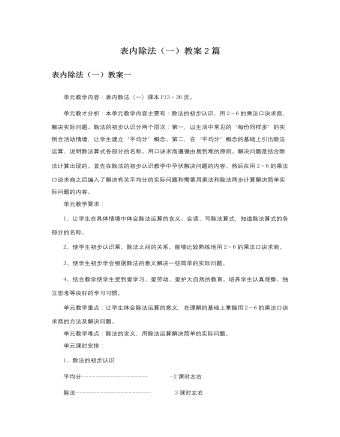
人教版新课标小学数学二年级下册表内除法(一)教案2篇
教后反思本节课给学生创设了良好的活动空间,把学生实际生活中听说过的见到的平均分现象展示给学生看,把生活和数学联系起来,在学生感受“同样多”的基础上概括出什么叫平均分。揭示平均分这一数学知识在生活中的应用,之后突出了学生三次实际操作。第一次,小组同学互相分水果,重视学生分的结果。体会感受“平均分”的含义。第二次,重视分法:15个橘子平均分成5份。体现了学生对物品的不同分法,建立了平均分的概念。第三次,分矿泉水,通过份数变化,观察分的就结果,深刻体会“平均分”,为认识除法积累丰富的知识。为学生营造探索的空间。第二课时:平均分的认识(二)教学内容巩固“平均分”。课本第15页的例题3。教学目标1.巩固“平均分”的概念,知道平均分就是每一份分得结果同样多。
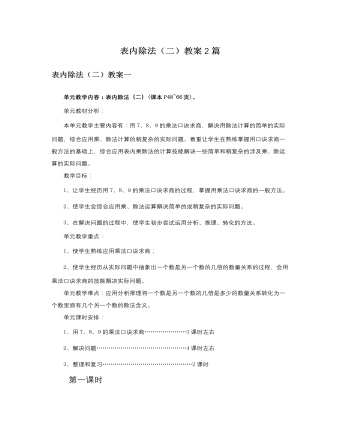
人教版新课标小学数学二年级下册表内除法(二)教案2篇
三维目标1.知识与技能(1)让学生经历用7、8、9的乘法口诀求商的过程,掌握用乘法口诀求商的一般方法。(2)使学生会综合应用乘、除法运算解决简单的或稍复杂的实际问题。2.过程与方法在解决问题的过程中,让学生初步尝试运用分析、推理和转化的学习方法。3.情感、态度与价值观让学生在学习中体验到成功的喜悦,增强学生学好数学的信心。重、难点与关键1.重点:使学生熟练应用乘法口诀求商,经历从实际问题中抽象出一个数是另一个数的几倍的数量关系的过程,会用乘法口诀求商的技能解决实际问题。2.难点:应用分析推理将一个数是另一个数的几倍是多少的数量关系转化为一个数里面有几个另一个数的除法含义。3.关键:以解决问题为载体,培养学生的数感。

